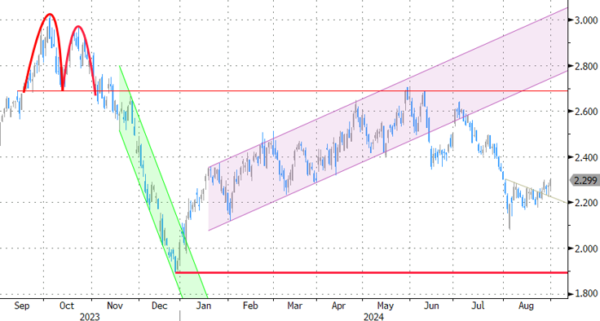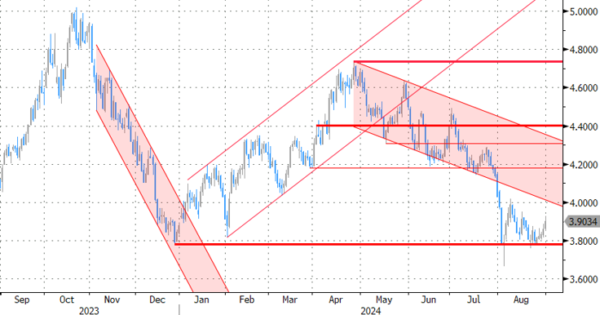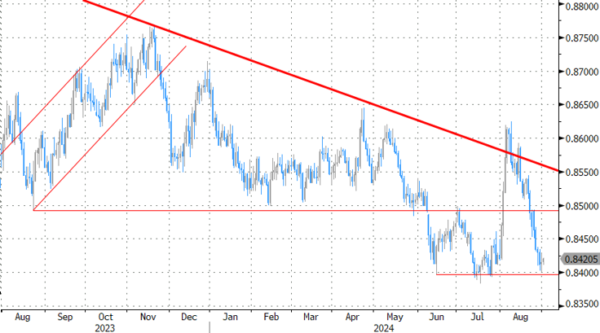Markets
European inflation figures and US PCE, spending & income data basically played second fiddle on Friday, triggering barely more than some intraday volatility in yields. Technical elements were at least as much of a driver. Support around the August lows waq tested earlier last week. Their survival preluded a countermove higher, be it within the existing ST narrow sideways trading ranges. US yields finished between 2.3 (3-yr) and 5 bps (30-yr) higher. German rates added 2.2-3.4 bps across the curve. It’s 10-yr tenor closed at the highest level since end-July. Oil prices abruptly tumbled below $80 per barrel (Brent) on a report ran by Reuters that OPEC+ is likely to go ahead with the planned output increases. Lingering (Chinese) growth concerns had some in the market assuming the oil cartel would have changed tack. The price of oil extends its fall during Asian dealings to $76.4. While driven by the contract roll as well, it does bring the August dip just north of $75 back in focus. The sharp oil decline came with consequences for the likes of the Norwegian krone. EUR/NOK rebounded from a two-week low. USD was well bid. The trade-weighted index recovered for a third day straight, further leaving the 100.6 support area behind. DXY closed around 101.7. EUR/USD’s three-day losing streak brought it back to the mid 1.10-1.11 area and USD/JPY topped 146. Sterling ended August’s wild ride at virtually the same level where it started the month. EUR/GBP tested the 0.84 big figure before finishing slightly north of it.
News this morning is very scarce and with an empty eco calendar and US financial markets closed for Labour Day that’s probably not going to change anytime soon today. That suggests limited and rangebound technical trading. Reuters is running a story that ECB policymakers are increasingly at odds on the outlook for growth and its impact on inflation. The divide means there’s no clear view on what to expect after the central bank will cut rates again in September. But that’s for next week. After a slow open today, the calendar does get a lot more interesting for markets. The US August ISMs are due tomorrow (manufacturing) and Thursday (services), along with the JOLTS job openings and the Fed’s Beige Book (Wednesday) and the payrolls report on Friday. Their releases are particularly critical for the size of this month’s Fed cut. With what is currently already priced in further out, any downside surprise would have to be material enough for adding to those bets even more. We’re instead especially interested in case of consensus-matching or slightly -beating outcomes.
News & Views
The Czech Ministry of Finance on Saturday presented a 2025 government budget that aims to reduce the budget deficit near 2.0% of GDP. The proposal includes a reduction of the deficit to CZK 230 bln down from a CZK 252 bln target for this year. In preparing this budget, the government had to strike a balance between delivering on a promise to return to return to fiscal orthodoxy while at the same time committing funds for more investments, meeting the target of 2% spending on defensive and other social spending. In this respect, the budget raises spending by CZK 124.1 bln and income by 146.1 bln. The government expects growth to reaccelerate to 2.7% from an expected 1.1% this year. The government will debate the budget before summitting a final version to Parliament by end-September. One of the junior coalition partners (Pirates Party) already indicated that it could not accept lower funding to support new housing. The Czech Republic is scheduled to hold parliamentary elections next year.
Regional elections in Thuringia and Saxony resulted in a big defeat for the parties of the three-party national government coalition of Chancellor Olaf Scholz. In Thuringia, preliminary results indicate that the far-right Alternative for Germany (AfD) could reach as much as 33.2 % of the votes, with the CDU reaching 23.6%. In Saxony both parties are seen neck and neck with the CDU seen potentially winning 31.9% of the votes while the AFD might reach 30.6%. Also the left-wing populist party Sahra Wagenknecht Alliance (BSW) profited from the decline in support for the ruling parties of the national government, securing 15.8% of the votes in Thuringia and estimated to have gained 11.8% in Saxony. The outcome of the elections will make it difficult to make coalitions on a regional level, but might also further pressure on the national government (SPD, Greens, Free Democrats) as Germany is preparing for 2025 parliamentary elections.
Graphs
GE 10y yield
The ECB cut policy rates by 25 bps in June. Stubborn inflation (core, services) make follow-up moves less evident. Markets nevertheless price in two to three more cuts for 2024 as disappointing US and unconvincing EMU activity data rolled in, dragging the long end of the curve down. The move accelerated during the early August market meltdown.
US 10y yield
The Fed in its July meeting paved the way for a first cut in September. It turned attentive to risks to the both sides of its dual mandate as the economy is moving to a better in to balance. Markets tend to err in favour of a 50 bps lift-off. The pivot weakened the technical picture in US yields with another batch of weak eco data pushing the 10-yr sub 4%. Powell at Jackson Hole didn’t challenge markets’ positioning.
EUR/USD
EUR/USD moved above the 1.09 resistance area as the dollar lost interest rate support at stealth pace. US recession risks and bets on fast and large (50 bps) rate cuts trumped traditional safe haven flows into USD. EUR/USD 1.12 was tested but survived. A (technical) dollar comeback then kicked in.
EUR/GBP
The BoE delivered a hawkish cut in August. Policy restrictiveness will be further unwound gradually on a pace determined by a broad range of data. The strategy similar to the ECB’s balances out EUR/GBP in a monetary perspective. Recent better UK activity data and a cautious assessment of BoE’s Bailey at Jackson Hole are pushing EUR/GBP lower in the 0.84/0.086 range.
















